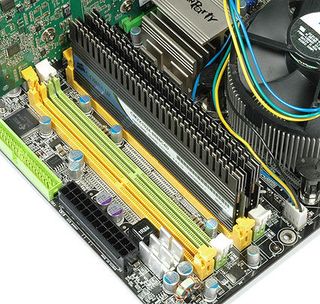Parallel Processing, Part 2: RAM and HDD
Single Or Dual Channel RAM; Single, Dual And Quad Hard Drives

In the first part of our parallel processing article series, we discussed the performance differences among single, dual and quad core processors, because an increased number of processing units delivers much better performance gains than any clock speed increase could. The performance benefits of processing workloads in parallel, or at least deploying multiple devices, is found not only in processors, though. Dual and even quad graphics setups have been around for years, and two more components have benefited from this trend too: RAM and hard drives.
Memory controllers were, in fact, the first component that went from a single unit to a parallel layout, utilizing two memory channels in an effort to increase bandwidth. In early 2003, Intel introduced the 865 and 875 chipsets, which transitioned Pentium 4 platforms on Socket 478 from a single DDR333 memory controller to dual-channel DDR400 logic. At that time, memory bandwidth was more than doubled on paper, but the performance impact was also experienced in real life. But what’s the situation today? Many notebooks run with only a single memory module (channel), and no one seems to notice an impact on performance. In addition, the current Intel Core 2 Duo processors come with a huge and sophisticated 2 MB or 4 MB second level cache Compare Prices on Core 2 Duo Processors, which reduces the impact of either poor or super-fast memory. Is dual channel memory really necessary?
Since we felt that the result of a test between single and twin channel memory configurations was somewhat predictable, we decided to go further. We added some more benchmarks to furnish this article, comparing the performance difference between a single hard drive and RAID 0 setups with two and four drives using popular benchmarks. While we already did lots of analytical articles on RAID, this time the focus is on mainstream desktop benchmarks, instead of storage benchmarks.
Join our discussion on this article!
Stay on the Cutting Edge
Join the experts who read Tom's Hardware for the inside track on enthusiast PC tech news — and have for over 25 years. We'll send breaking news and in-depth reviews of CPUs, GPUs, AI, maker hardware and more straight to your inbox.
Current page: Single Or Dual Channel RAM; Single, Dual And Quad Hard Drives
Next Page RAM Parallelism: Single And Dual Channel-
(Firt of all: Excuse my poor English... )Reply
mmm yours memory tests don't convince me. You should run, for example, Winrar AND Lame IN PARALLEL/SIMULTANEOUS (i.e multitasking), otherwise, caches don't are flushed (and it's when dual channel really is important). Note that it's not a superflous situation; under normal use a system commonly have several huge memory applications run concurrently (word, browser whith a lot of tabs open, anti-virus, etc. )
el_bot -
hellwig I doubt anyone from Tom's will see this comment on such an old article, but it would have been interesting to see Single-vs.-Dual channel memory using an AMD processor. Since Tom's like Intel, the new Core i7's would also be beneficial. The point is, the article acknowledges the Core 2's have a tremendous amount of L2 cache to combat FSB (and consequently Memory) latencies. How is the comparison with an AMD or nwe Core i7 where there is NO FSB and the L2 Cache is significantly reduce? I would imagine this is where dual/tripple-channel shows is mustard. I hope we see a single vs. dual vs. triple channel comparison soon.Reply -
junghm69 My Windows Experience Index 3D gaming graphics score goes up from 3.8 to 5.1 when I switch from dual channel to single channel. This makes absolutely no sense. I thought dual channel was supposed to be better than single channel. Can anyone explain this?Reply
I seriously doubt that this score is accurate. I am using the built in graphics controller on the motherboard which is an AMD 760G chipset (ATI HD 3000 or 3200 I think). I've used Radeon HD 5450 video cards on similar systems and they give me a score of 5.4. How can a built in graphics controller give me a 5.1?
AMD Athlon II X3 435 Rana (2.9 ghz)
Asus M4A78LT-M motherboard
4 GB G.Skill DDR3-1333 (2x2GB) F3-10600CL9D-4GBNT CL9-9-9-24 1.5V
Windows 7 Ultimate 64-bit -
junghm69Reply
because if you used 2 different memory chips both will run at the speed of the lowest memory chip when you activate dual channel in your motherboard -
Caramac That earlier article on Processors doesn't work, so I'll add this:Reply
Intel HyperThreading - leading to the "H T" on the 'Intel Inside' sticker of computers with that 875p chipset and a single core Pentium 4 processor.
It equals simulated dual core tech.
Some Core processors also have HT.
http://www.tomshardware.com/forum/340555-28-intel-hyperthreading-helpful
Most Popular

